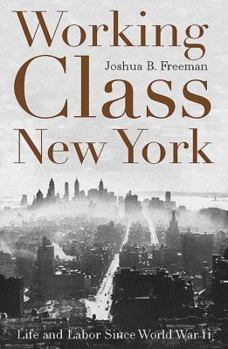Working-Class New York
Select Format
Select Condition 
Book Overview
A "lucid, detailed, and imaginative analysis" (The Nation) of the model city that working-class New Yorkers created after World War II--and its tragic demise More than any other city in America, New... This description may be from another edition of this product.
Format:Hardcover
Language:English
ISBN:1565845757
ISBN13:9781565845756
Release Date:January 2000
Publisher:New Press
Length:409 Pages
Weight:1.75 lbs.
Dimensions:1.4" x 6.4" x 9.5"
Related Subjects
20th Century Economics Historical Study & Educational Resources History Labor & Industrial Relations Minority Studies Modern (16th-21st Centuries) Politics & Government Politics & Social Sciences Social History Social Science Social Sciences Specific Demographics State & Local TextbooksCustomer Reviews
3 ratings
A highwayscribery "Book Report"
Published by Thriftbooks.com User , 14 years ago
The narrative in "Working Class New York," grows less interesting along with the declining labor movement it chronicles. That's no criticism. After all, Joshua Freeman did not write a novel, rather penned an important nonfiction and academic effort that tells the story of New York through its workers. "Working Class New York," is wonderfully done and demonstrative, at every turn, with the author's passion for his subject. But, for labor enthusiasts, the end can't match the beginning for excitement. In the early chapters, the poesy of labor reigns as the Hatters, Printers, Furriers, Elevator Operators, Milliners, Bakers and Tugboat workers, representing a rainbow of crafts and productive industries, bring the world's mightiest city to a halt through mass strikes driven by the underlining goal of reorganizing society itself. Freeman's analysis of New York's economic structure, and how it created a textured union movement unequaled in the rest of the country, is fascinating and as much a love letter to the unions as to Gotham itself. Indeed, the author frequently asserts that the city's best face was the lined countenance of the laborer or craftsperson enlightened by their recognition of a shared destiny, on the shop floor and front stoop, with similarly situated souls. "Working Class New York," meticulously follows the labor movement's progress and retrenchments, starting with its halcyon days in the post-war 1940s. It makes no bones about the powerful impetus communist politics played, and the subsequent loss of energy that coincided with the reds being chased out of American labor. Freeman illustrates how the union movement reflected changes in the city as it lost manufacturing jobs and embraced the financial and service-based industries. His mapping of municipal unionism's rise has less of a workerist flavor and more of what the departed Allan Bloom called the "Nitzscheanization of the left," as ethnicity and cultural issues consumed unions' internal power struggles and drove their industrial strategies. And the book details how the decline of labor in New York reflected its nationwide losses as the country grew more individualistic and market-oriented in the 1970s and '80s. Freeman's chapter on how financial types used The Big Apple's fiscal crisis in the late 1970s to undermine and rollback the unions' hard-earned, and unique urban social democracy, is must-read for anyone interested in those dynamics affecting the American workplace for nigh on a generation now.
Why New York Is the Still the Heartbeat of Labor
Published by Thriftbooks.com User , 24 years ago
Labor leaders and activists who share the desire to see the U.S. labor movement regain its power should read "Working Class New York: Life and Labor Since World War II" by Queens College associate professor of history Joshua Freeman, Unlike many labor history books, which often leave the reader with little insight into how to help shape the present, Freeman's new book succeeds in laying the groundwork for strategic thinking about the future of the labor movement. Providing more than a just a narrative of past events, Freeman constructs a useful framework for analyzing labor's present situation, exposing both the role of broad structural forces-changes in the economy, politics, and culture-and the role of decisions made by the labor leadership in defining labor's trajectory. For those with a fear of starting and not finishing a 400-page "history" book, fear no more. This book is an engaging and fast read; and it reveals facts that most labor leaders and activists are probably unaware of. (For example, one of the first actions of the post-WWII strike wave occurred in New York City with the September 1945 strike of 15,000 building service workers, the predecessors of today's SEIU 32B-J.) "Working Class New York" is one of the best labor history books published in the last two decades for the simple reason that its vantage point is not as narrow (one industry or one union in a particular period) or as wide (the US labor movement as a whole) as others. By focusing on the history of the organized working class in one particular city, Freeman avoids a problem that has often plagued labor historians: i.e. the "fitting" of labor history into preconceived notions, stereotypes, or ideological biases. Instead, Freeman's book examines the full range of forces that propelled both the New York City labor movement's expansion and decline in the twentieth century. Today, the task for labor leaders and activists is to absorb the lessons of the past and use them to chart labor's future of growth. "Working Class New York" provides a valuable resource for anyone interested in helping to steer that course.Greg Tarpinian is Executive Director of the Labor Research Association ().
smart and thoughtful book
Published by Thriftbooks.com User , 24 years ago
This insightful, intelligent book not only writes from the usual historian's view of events but also describes the cultural and personal context of New York in the post war period. Highly recommended for New York City buffs and for people interested in labor history or the history of real people.





